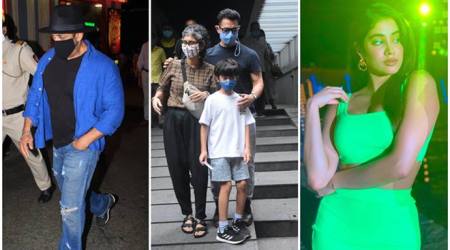 Khosla Ka Ghosla released in 2006.
Khosla Ka Ghosla released in 2006. A middle-class man falling into the trap of land grabbers and losing his lifetime savings — this isn’t just a snippet from the core plot of Khosla Ka Ghosla, but a real-life incident in writer Jaideep Sahni’s family, which impacted him so deeply that wrote a screenplay around it. He drafted it for one-and-a-half-years with such precision, that Dibakar Banerjee immediately decided to make his Bollywood directorial debut that went on to win National Award for Best Feature Film in 2006.
Dibakar Banerjee and Jaideep Sahni were collaborating on a feature film for the first time. They had a long-term association from their advertising days and planned the movie during breaks from their desk jobs. So, if either of them had doubts, Khosla Ka Ghosla would’ve never been made.
 Ranvir Shorey played the role of Bunty, son of Anupam Kher’s Kamal Kishore Khosla in Khosla Ka Ghosla. (Photo: Express Archives)
Ranvir Shorey played the role of Bunty, son of Anupam Kher’s Kamal Kishore Khosla in Khosla Ka Ghosla. (Photo: Express Archives) Khosla Ka Ghosla went on floors in 2003. Shot at a shoestring budget in 45 days, the real challenge was to release the film. The first investors, Padmalaya Telefilms of Hyderabad, pulled out of the project, leaving things in mayhem. Other financiers who showed willingness to bankroll it, came with conditions. While some wanted recasting an actor, others demanded an item song and an action sequence. But Dibakar and Jaideep were adamant to not alter the heart of the story.
“Content is king, but distribution is god. It took a long time for the film to release, in fact there was a time when we thought it wouldn’t just release at all and were quite upset. It was a small budget film that went on to become a cult. It’s a timeless story,” actor Tara Sharma, who plays Meghna told indianexpress.com.
Khosla Ka Ghosla finally released after three years of being shot, when UTV Motion Pictures came to its rescue and distributed it.
 Actors Anupam Kher, Ranvir Shorey, Parvin Dabas and Tara Sharma in a still from Khosla Ka Ghosla.
Actors Anupam Kher, Ranvir Shorey, Parvin Dabas and Tara Sharma in a still from Khosla Ka Ghosla. “It is a film that makes you laugh and touches you at the same time. People said it was a Hrishikesh Mukherjee type of a film because it’s about a common man and is laced with comedy. You have to be grounded and feel the honesty of the film to be able to deliver. And for that a lot of credit goes to Dibakar and Jaideep. The fact that we could finish it and release it was a big deal,” Parvin Dabas, who plays Chiraunji Lal Khosla aka Cherry says.
Khosla Ka Ghosla can easily be categorised as one of the first independent films that dug deep into the middle-class aspirations weaved around a real estate fight. Though today, one cannot replace Anupam Kher as the naive Khosla, the role was first offered to Rishi Kapoor. On the other hand, Vinay Pathak auditioned to play Khurana, which was ultimately done by Boman Irani. According to Jaideep, they felt so guilty of not casting Vinay as the main antagonist, they ended up casting him as Asif Iqbal.
“Asif Iqbal’s character was written as a powerful character who would handhold the Khosla family and the audience through the twists and turns of the notorious real estate trade,” Jaideep told Film Companion previously.
 The casting of Boman Irani as the evil property dealer was one of the highlights of Khosla Ka Ghosla. (Photo: Express Archives)
The casting of Boman Irani as the evil property dealer was one of the highlights of Khosla Ka Ghosla. (Photo: Express Archives) But it was Boman as Khurana who took a major share of the cake. This, despite many wondering if a Mumbai-born Parsi man could do justice to the role of a Delhi-based property dealer. Boman, who was also shooting for Munna Bhai MBBS, said he was “determined to make it work” after so many people “raised their eyebrows” over his casting.
Jaideep was the bridge between Dibakar and Boman to convince them to work with each other. “Boman was a little hesitant about doing Hindi films. And Dibakar had in his mind, a bigger pot-bellied Punjabi property agent in mind, which is not a wrong imagination from what was on paper,” Jaideep added.
After spending one entire evening and night speaking to them separately, he managed to get the film’s Khurana onboard. Boman joined the shoot midway, but all that he got to prepare for his part was an audio recording of a real property dealer from Rajendra Nagar, Delhi and some videos to understand their lingo and how they behave with clients. Adding to the method was Dibakar’s decision of keeping Boman away from the remaining cast to stop him from “humanly connecting” with the Khurana family.
Boman got to meet Anupam Kher on his second day on set. Kher, who played the patriarch in film, had a bigger role off camera – being the daddy on set too!
“This film was made while enduring a lot. We were thrown out of the hotel, there was a taxi strike, limited resources and the Delhi heat. I knew if the team gets scattered, the morale would run low and the team would disintegrate. So I would keep them involved, play games, take them out for dinners. I needed to go beyond my role of an actor,” Kher told Film Companion.
 In Khosla Ka Ghosla, Anupam Kher’s family plans to deceive Kishen Khurana to take back their land which the property dealer has grabbed by force. (Photo: Express Archives)
In Khosla Ka Ghosla, Anupam Kher’s family plans to deceive Kishen Khurana to take back their land which the property dealer has grabbed by force. (Photo: Express Archives) “It’s a very universal story that resonates with so many people. We had a great time making it. I feel blessed to be part of it and made some great friends,” Tara said, adding that she became aware of mafia that grabs land after working in the film.
There were no vanity vans, no luxuries and everything was on a tight supply. The cast and crew faced many challenges and one such occasion was when they fell short of the film reel. The sequence where a drunk Khurana escorts Navin Nischal’s Sethi to the car to see him off. It was done in a single shot on a hand held camera because they had just one can of film left.
“Khosla Ka Ghosla was truly a collaborative effort. The biggest highlight of the film was the cast’s bonhomie, there were tough times while shooting but everybody stuck through it. Everybody knew we were making something special. It is not a film that comes along everyday,” Parvin Dabas added while speaking to us.
When the film faced an uncertain release with no money for its post-production, Jaideep went on a backpacking trip to Italy to vent his frustration. It was there, that Dibakar gave him the news of producer Savita Raj Hiremath managing to raise funds for its music. Jaideep quickly got on to writing the lyrics and started faxing them to music directors Bapi–Tutul and Dhruv Dhalla. So the next time you hear “Chak De Phattey” you’ll know it was penned down by Jaideep in a small hotel in Italy.
“The film is very relevant even today. Such stuff still happens, such scams still happen, and that’s because of the kind of people we are. There are always some people who want to make an extra buck and then there are some people who are easily trusting. So the story still makes a lot of sense even if the film was to be made today,” Parvin said.
According to Tara, the television screening and the boom of OTT gave a new lease of life to the film and helped in it becoming a cult. “People ask about a sequel but Dibakar and Jaideep would always say when something is done and genuinely unique, you don’t want to tamper with it again,” she asserted.
Khosla Ka Ghosla eventually made a profit of double its budget. It was later remade in in Tamil as Poi Solla Porom (2008) and in Kannada as Rame Gowda Vs. Krishna Reddy (2010).
(With inputs from Komal RJ Panchal)
- The Indian Express website has been rated GREEN for its credibility and trustworthiness by Newsguard, a global service that rates news sources for their journalistic standards.

































